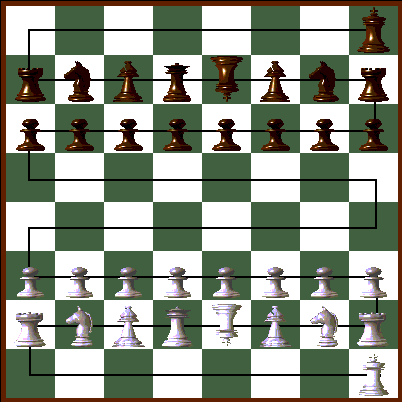ROLLING KINGS
By Peter Aronson
Introduction
Rolling Kings is a Chess variant where the Kings, starting in an otherwise unoccupied back row, move each turn along a winding King-line, passing in a boustrophedonic fashion across the board like all-devouring juggernauts, capturing any piece on either side that they encounter, except the opposing King. All other pieces start two spaces closer to their opponents than in International Chess, and the King's position next to the Queen is filled by a Mock King, who moves like a orthodox chess King or slides along the King-line.
Board and Setup
The following board shows the path of the King-line (which leads from h1 to h8, passing through every square on the board), in the direction that the white King traverses it. The black King simply traverses it in the opposite direction (from h8 to h1).
+---+---+---+---+---+---+---+---+
8 | >>|>>>|>>>|>>>|>>>|>>>|>>>|>> |
+---+---+---+---+---+---+---+---+
7 | ^<|<<<|<<<|<<<|<<<|<<<|<<<|<< |
+---+---+---+---+---+---+---+---+
6 | >>|>>>|>>>|>>>|>>>|>>>|>>>|>^ |
+---+---+---+---+---+---+---+---+
5 | ^<|<<<|<<<|<<<|<<<|<<<|<<<|<< |
+---+---+---+---+---+---+---+---+
4 | >>|>>>|>>>|>>>|>>>|>>>|>>>|>^ |
+---+---+---+---+---+---+---+---+
3 | ^<|<<<|<<<|<<<|<<<|<<<|<<<|<< |
+---+---+---+---+---+---+---+---+
2 | >>|>>>|>>>|>>>|>>>|>>>|>>>|>^ |
+---+---+---+---+---+---+---+---+
1 | ^<|<<<|<<<|<<<|<<<|<<<|<<<|<< |
+---+---+---+---+---+---+---+---+
a b c d e f g h
This next board adds the pieces in their starting array.
+---+---+---+---+---+---+---+---+
8 | >>|>>>|>>>|>>>|>>>|>>>|>>>|>K |
+---+---+---+---+---+---+---+---+
7 | R<|<N<|<B<|<Q<|<M<|<B<|<N<|<R |
+---+---+---+---+---+---+---+---+
6 | P>|>P>|>P>|>P>|>P>|>P>|>P>|>P |
+---+---+---+---+---+---+---+---+
5 | ^<|<<<|<<<|<<<|<<<|<<<|<<<|<< |
+---+---+---+---+---+---+---+---+
4 | >>|>>>|>>>|>>>|>>>|>>>|>>>|>^ |
+---+---+---+---+---+---+---+---+
3 | p<|<p<|<p<|<p<|<p<|<p<|<p<|<p |
+---+---+---+---+---+---+---+---+
2 | r>|>n>|>b>|>q>|>m>|>b>|>n>|>r |
+---+---+---+---+---+---+---+---+
1 | ^<|<<<|<<<|<<<|<<<|<<<|<<<|<k |
+---+---+---+---+---+---+---+---+
a b c d e f g h
Where the letters have their usual meanings, and M and m indicate the Mock Kings. On the graphic board:

Mock Kings are indicated by upside-down Kings.
General Rules
The rules of Rolling Chess are identical to those of orthodox chess, except when noted otherwise. Victory is by capturing the opposing King, not by checkmate, as your King's movement is not under your control. The situation where the white King is on h4 and the black King is on h5 is a stalemate, and hence a draw, as Kings may not capture Kings. Each turn you move a piece other than your King, and then your King automatically moves one square along the King-line.The Movement of Pieces
The Queen, Rook, Bishop, and Knight all move as they do in orthodox chess.Pawns move as they do in orthodox chess, except that there is no two-square initial move, and there is no en-passant capture. Pawns promote on the usual squares, and may promote to a Mock King, a Queen, a Rook, a Bishop or a Knight.
The King moves automatically each turn along the King-line. The white King starts at h1, and proceeds to g1, f1, e1, d1, c1, b1, a1, a2, b2, c2 and so on. The black King starts at h8, and proceeds to g8, f8, e8, d8, c8, b8, a8, a7, b7, c7 and so on. A player's King moves immediately after the player moves one of their other pieces, and captures any piece of either side on the square on to which it moves, except for the opposing King. There is, of course, no castling.
The Mock King is not royal -- capturing it does not win the game. The Mock King may move either like an orthodox chess King, or may slide along the King-line in either direction. For example, in the following diagram:
+---+---+---+---+---+---+---+---+
8 | >>|>>>|>>>|>>>|>>>|>>>|>>>|>> |
+---+---+---+---+---+---+---+---+
7 | ^<|<<<|<<<|<<<|<<<|<<<|<<<|<< |
+---+---+---+---+---+---+---+---+
6 | >>|>>>|>K>|>>>|>>>|>>>|>>>|>^ |
+---+---+---+---+---+---+---+---+
5 | ^<|<<<|<<<|<<<|<<<|<<<|<<<|<< |
+---+---+---+---+---+---+---+---+
4 | >>|>>>|>>>|>>>|>>>|>>>|>>>|>^ |
+---+---+---+---+---+---+---+---+
3 | ^<|<m<|<k<|<<<|<<<|<<<|<<<|<< |
+---+---+---+---+---+---+---+---+
2 | >>|>>>|>>>|>>>|>>>|>>>|>>>|>^ |
+---+---+---+---+---+---+---+---+
1 | ^<|<<<|<<<|<<<|<<<|<<<|<<<|<< |
+---+---+---+---+---+---+---+---+
a b c d e f g h
The white Mock King on b3 could capture the black King on c6 by moving along the path: a3, a4, b4, c4, d4, e4, f4, g4, h4, h5, g5, f5, e5, d5, c5, b5, a5, a6, b6, c6. A Mock King may not jump over other pieces, thus, in the example above, the Mock King may not slide to the right/down, as its own King blocks the King-line in that direction. A Mock King can reach any square of an otherwise empty board.
Notes
Rolling Kings was designed as an entry in the Chess Variant Pages 32-turn Challenge. It was partly inspired by the Checkers variant, Cats and Dogs. Rolling Kings is limited to 32 turns, as, if the game lasts that long, the two Kings will meet head-to-head, resulting in a stalemate. In reality, the game is never going to last that long, as the Kings become increasingly vulnerable as they move closer to the front of the board, forcing their own defenders out of the way or even capturing them!The Mock King's sliding move along the King-line in theory gives it access to the entire board. In practice, the lines of pawns usually interfere. Chess pieces are often described as moving diagonally or orthogonally. David Parlett adds the word hippogonally for pieces that move like Knights. To invent a term of my own, the King and Mock King in Rolling Kings can be said to move boustrophedonically, from the Greek word boustrophedon, meaning as an Ox plows (usually applied to an ancient style of writing where alternate lines were written in opposite directions).
Zillions of Games
I have written an implementation of Rolling Kings for Zillions of games. It seems to overvalue the Mock King, but maybe Zillions has figured out something I haven't. You can download it here:
Rolling Kings is a competing entry in the 32-Turn Challenge.
Written by Peter Aronson.
WWW page created: April 29th, 2000.
